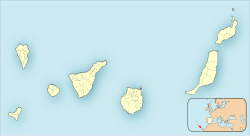Tejeda
| Tejeda | |
|---|---|
| Municipality | |

Mist over the caldera of Tejeda
|
|
 Municipal location in Gran Canaria |
|
| Location in the Canary Islands | |
| Coordinates: 27°59′40″N 15°36′50″W / 27.99444°N 15.61389°WCoordinates: 27°59′40″N 15°36′50″W / 27.99444°N 15.61389°W | |
| Country | Spain |
| Autonomous Region | Canary Islands |
| Province | Las Palmas |
| Island | Gran Canaria |
| Area | |
| • Total | 103.30 km2 (39.88 sq mi) |
| Elevation | 1,050 m (3,440 ft) |
| Population (2013) | |
| • Total | 2,028 |
| • Density | 20/km2 (51/sq mi) |
| Time zone | GMT (UTC+0) |
Tejeda is a village and a municipality in the mountainous central part of the island of Gran Canaria in the province of Las Palmas in the Canary Islands.
The village of Tejeda is situated 6 km (4 mi) north-west of the Pico de las Nieves and 23 km (14 mi) south-west of the island capital Las Palmas.
The municipality's area is 103.3 km2 (39.9 sq mi), spreading near the centre of the island, on the latter's west side.
The south-eastern part of its territory includes the highest point of Gran Canaria island, Pico de las Nieves ("Snows Peak") - 1,949 m (6,394 ft). Other remarkable summits in the municipality are Roque Nublo ("Cloud Rock") 813 m (2,667 ft) and Roque Bentayga ("Bentayga Rock") with its ritual place (almogarén) and other features. Close by are the cuevas del Rey ("the King's caves", 1 km to the west of Rock Bentayga), an antique cave house village with granaries; and 2 km further west the antique cave house village of Acusa Seca. All these sites are listed Spanish Heritage as Properties of cultural interest ("Bien de Interés Cultural").
The village of Tejeda sits on the eastern edge of a volcanic basin or crater that bears its name (caldera de Tejeda).
The caldera’s dimensions are 28 km x 18 km, with a surface that extends from the head of Agaete's ravine (barranco de Agaete) near Artenara, to Verde Andén ("Green Platform") in the west, Veneguera and the head of Mogán ravine (barranco de Mogán) up to Arguineguín's ravine (barranco de Arguineguin). Only half of its perimeter remains standing; on what is left of it are found a few green-bluish peaks (such as "azulejos" de Veneguera - "Veneguera's tiles") and below these are the oldest basalts of the island, primitive substrate of Grand Canary.
The caldera was produced in probably less than two hours, by the explosion of the residual magma chambers During the collapse of the caldera de Tejera ignimbrite rock was produced, with a pink matrix dotted with white crystals. It exists because the explosive eruption by which the caldera collapsed was so powerful that the magma was pulverized in a very fine spray and created almost microscopic structures in the matrix rock. Ignimbrita is found on the outside of the periphery of the caldera.
The caldera also bears traces of a 2 millions years’ period of evolution. This is especially notable at the heads of the Agaete ravine (barranco de Agaete) and Mogan ravine (barranco de Mogan), where we can see horizontal basaltic lavas in their lower parts and, above, thicker material in sloping layers.
...
Wikipedia

